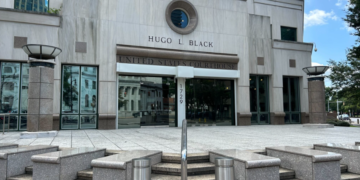November 24, 2025 Story by: Editor
A federal court has ordered a significant redrawing of two state Senate districts in the Montgomery, Alabama area, finding that the prior map diluted the voting strength of Black residents in violation of the Voting Rights Act of 1965.
On Monday, November 17, U.S. District Judge Anna Manasco issued an order requiring the use of what is designated “Remedial Plan 3” for two Senate districts — District 25 and District 26 — beginning with the 2026 mid-term elections.
Background and legal findings
Judge Manasco, a Trump appointee, found that the state’s mapmakers packed Black voters into one Montgomery district while cracking adjacent communities to limit their ability to elect candidates of their choice. This practice, the court concluded, violates Section 2 of the VRA, which prohibits election laws or maps that result in the dilution of minority voting power.
The court rejected similar claims about the Huntsville area, finding that plaintiffs had not demonstrated that an additional majority-Black district could be drawn there while meeting legal and geographic requirements.
The ruling stems from a 2021 lawsuit brought by the Alabama State Conference of the NAACP, Greater Birmingham Ministries, and several Black voters, represented by the ACLU, NAACP Legal Defense Fund, and Southern Poverty Law Center.
“This decision proves that when we challenge injustice, we can make progress. Alabama must now draw fairer districts in Montgomery, but let’s be clear—leaving Huntsville untouched still denies many Black Alabamians their rightful representation,” said Benard Simelton, president of the Alabama State Conference of the NAACP.
It was also not immediately clear when maps might be redrawn, should Manasco’s ruling be upheld. A federal court in 2017 ruled that 12 of Alabama’s 105 House districts violated the Voting Rights Act and had to be redrawn. The Legislature did so during that year’s regular session. The Legislature in 2023 drew a new map in a special session; the court rejected the map as unresponsive and ordered its own. Manasco, who ordered new maps be put in place for the 2026 elections, scheduled a status conference for next Thursday.
The plaintiffs claim that the districts in Montgomery and Huntsville dilute Black voting power in the state in violation of the VRA by unconstitutionally packing Black voters into particular districts.
The remedial process and map selection
The mapping process was overseen by a court-appointed Special Master, Richard Allen, who was the same expert used for the state’s 2023 congressional map redrawing. He submitted three draft remedial plans (Remedial Plans 1, 2 and 3). Although his recommendation favored Remedial Plan 1 or 2, the court selected Plan 3.
- Remedial Plan 1 would have changed District 25’s BVAP to ~51.6 %, District 26 to ~49.7 %, and District 30 to ~20%.
- Remedial Plan 2 would have set District 25’s BVAP at ~53.6 %, District 26 at ~48.3 %, and District 30 at ~19.1%.
- Remedial Plan 3, the adopted version, moves District 25 into southern Montgomery County and expands District 26 into Elmore County (currently part of District 25).
Judge Manasco ordered that the remedial map be used in the 2026 and 2030 mid-term elections as well as in any special elections for Districts 25 or 26.
Impact on representation and elections
Under the new map:
- District 25 (formerly ~29 % BVAP) rises to ~51.1 % BVAP; analysts estimate Black voters in that district will have a nearly 90 % chance of electing a candidate of their choice.
- District 26 (formerly ~66.1 % BVAP) falls to ~43.9 % BVAP; the chance of electing a preferred candidate is estimated at around 53 %.
These changes are seen as meaningful, especially for Black voters in Montgomery. However, the overall party balance in the state Senate is not expected to shift substantially—Republicans currently hold a super-majority.
Political and institutional reactions
The decision comes after the Alabama State Conference of the NAACP, Greater Birmingham Ministries and Black voters in Montgomery filed the original lawsuit, arguing that Black voters had been marginalized via the districting. Although the complaint also raised concerns about Huntsville, Judge Manasco found insufficient evidence to support a violation there and limited the remedy to the Montgomery area.
The state’s highest executive, Governor Kay Ivey, opted not to call a special legislative session to redraw the map, citing the pending Callais v. Louisiana matter before the U.S. Supreme Court, which addresses the constitutionality of majority-minority districts. With no special session, the court took on the redistricting directly.
Wes Allen, Alabama’s Secretary of State and defendant in the litigation, in October called Plan 3 “the least bad of several bad options.”
What’s next
Both parties have 30 days to file appeals of the decision.
Implementation of this map means the 2026 mid-term will be conducted under the new boundaries for Districts 25 and 26. What remains to be seen is how candidates will adjust their strategies under the changed demographics, and whether these two districts — especially District 25 — will deliver different representation as intended by the court.
For the broader redistricting landscape in Alabama, this decision reinforces ongoing federal oversight of state maps under the Voting Rights Act. Earlier actions include the 2021-22 congressional map redraw, which impacted Alabama’s 2nd and 7th congressional districts and drew national attention.
Ultimately, this map-order may serve as a benchmark for how courts impose remedial maps when state legislature.
Source: Alabama Reflector / Alabama Political Reporter

















